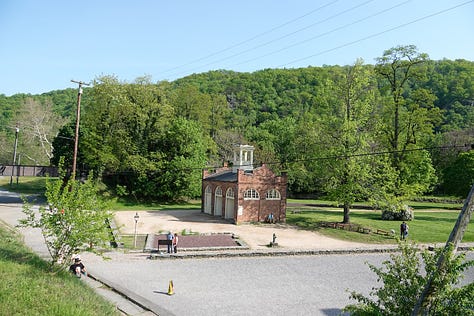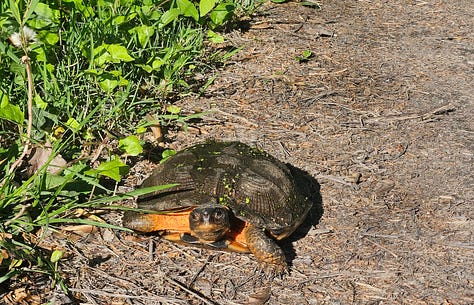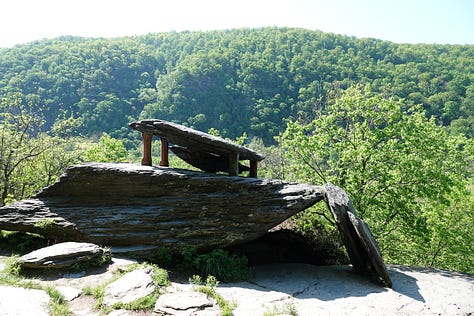In my northern high school in the ‘80s, if John Brown was mentioned, it was not as a hero. My history teacher was a staunch reactionary who was infamous for deliberately dilly-dallying during the school year so that he never had to teach beyond the end of World War II. He was not quite like the current batch who suggest that we were on the wrong side in that war, and refuse to acknowledge that the Civil War was fought over slavery, but all I remember of John Brown was that he was a radical and foolish, and not a moral firebrand who martyred himself for the cause of freeing the enslaved.
We weren’t even taught that “Battle Hymn of the Republic” was based on “John Brown’s Body,” the song that told the story of his martyrdom. But enough kvetching about my mediocre education at Nutley Senior High School. Lifelong learning and autodidactism1 are the way to go. And that’s why we began our road trip by visiting Harper’s Ferry, which some call the first battleground of the Civil War, long before Fort Sumter.
I never thought of visiting until I watched a travel or nature show where they visited. I thought it was Baratunde Thurston’s America Outdoors, but I honestly can’t remember now. Located at the confluence of the Shenandoah and Potomac rivers, the railroad runs over the river and through a mountain, and the tracks were there when John Brown and his raiders took the armory. A monument to him overlooks this building, called John Brown’s Fort. It was dismantled in 1891 and brought to the Columbia Exposition, then returned home, then moved to nearby Storer College for a time, before being purchased by the National Park Service and restored to where it now stands, about a hundred and fifty feet from its original location on Murphy Farm.2



That building gets around. The town of Harper’s Ferry itself has a population of 267, according to the sign in the bar called The Rabbit Hole, which serves a good beer and a tasty red rice and lentil burger. (They serve a beef one too, but I was pleasantly surprised that decent veggie options abounded around this small town, and at most of the places we stopped along this trip.)
The drive into town from the east takes you along the Potomac rapids and gives you a tease of the beautiful river valley. We stayed at the Light Horse Inn, a comfy and reasonable bed & breakfast uphill from Lower Town where the armory resides, which is just above The Point. That’s what they call the point of land at the very edge of town where you can take a footbridge across the river to the hiking and biking trails. It was a scorcher of a day, so we walked to the water, dipped in our toes, and took a short walk in the shade along the bank, watching some whitewater rafters and peering at soaring turkey vultures in the hope they’d become eagles.
The sun chased us indoors where we bought an extra hydration bladder at an outfitter and filled it from their well for Appalachian Trail through-hikers, and then climbed several stories of stairs up the side of the hill to get to the Rabbit Hole for that beer. To park at the train station, we opted to buy an $80 America the Beautiful annual National Park Pass instead of $35 for a three-day pass to cover today and tomorrow. It would pay for half itself on this trip alone. National Parks have always had a fee since their inception; I’m torn about it. I’d rather they be funded fully by taxes, as I don’t want the entry fee to keep people from visiting, but they are very crowded already. Even on an unseasonably hot Sunday, the area was brimming with people.
The next morning I woke early to avoid the heat, and go for a bike ride along the river. I had to carry my bike down a spiral iron staircase on the other side, the only time I was glad that I took my Trek Marlin 5 “hybrid” trail bike, which is much lighter than my usual ride. The dirt road was an easy and beautiful ride. I saw at least two dozen male Northern Cardinals that morning, deep red healthy fellas who weren’t shy about eating on the side of the trail. The lush green growth and the old worked stone were symbolic of the site’s combination of nature and history. I also met a Northern Map turtle chilling on the side of the road.



I found a dead juvenile black rat snake as well, and tried to keep my eyes on the trail so as not to flatten its cousins. It wasn’t a great trip for seeing animals, but I’d see a live snake, photograph a raptor, save a groundhog from traffic, and avoid plenty of squirrels, crows, and chipmunks on the road ahead. I also saw a nearly tame whitetail deer in the parking lot as I readied my bike! I kept the ride short to avoid the punishing sun, and not to miss the breakfast part of Bed & Breakfast. After enjoying a perfect plate of waffles, scrambled eggs, and crisp bacon, we climbed up the hill to visit the ruins of an old church and see “Jefferson Rock,” where the eponymous President enjoyed his view of the environs in 1783. It is a steep climb, and after my long bike ride, I let the Subaru do the climbing up the switchbacks to the top.
The view was spectacular. The table of rocks was once precariously balanced on another stone, but by 1855 so many people had teeter-totted it on its fulcrum that it was in danger of toppling down the hillside. To preserve it, the metal base was built sometime before 1890. The ruins of St. John’s Episcopal Church, built in 1851 by Irish immigrants, stands at a high point not far from Jefferson Rock. A newer church down the hill is open to congregants. I mention this because Brown was a man of faith who could not abide the atrocious injustice of slavery. In a country where abolitionists allied with slavers to free themselves from the yoke of monarchy at the expense of the enslaved, martyrs like John Brown, enslaved rebel Nathanial “Nat” Turner, and publisher Elijah P. Lovejoy—who was murdered by a mob in St. Louis, for printing anti-slavery newspapers—stand apart.3



After visiting the church, we took the road to Skyline Drive in Shenandoah National Park in Virginia. That’s for next Sunday. Here’s my fellow Rutgers alumn Paul Robeson singing “John Brown’s Body.”
What can I recommend this week? I finally watched season 2 of The Mandalorian for May the 4th, and I highly recommend it. It’s probably the best use of the Star Wars universe since 1983, with an episodic story that visits one world of wonder after another. My favorite? When “Mando” has to bring an amphibian woman and her jar of eggs to Mon Calamari water planet, and they get chased into a cave full of giant alien spiders. It’s very much like the old Paladin TV show, as Pedro Pascal’s Mandalorian has a righteous code and makes no attempts to bend it for convenience’s sake. It’s a load of fun and made me feel like a kid again. Solo: A Star Wars Story was also good fun, if you want a heist movie in that world.
If a Star War ain’t your thing, the post-apocalyptic alt-’50s universe of Fallout may be up your atomic alley. As one who played the first two games obsessively, I’ll say that it gets the tone perfectly right, and has plenty of wonder and delight for fans and newcomers alike. Some scenes capture the games’ ironic sense of humor perfectly, and the new stuff just rings true. Yep, there’s zombies—I mean, ghouls—but they talk, and one may even be the main character. Noseless and bald or not, he’s got the rizz and big dick energy. The show is funny, unpredictable, and always interesting to look at.
From 1999, Ratcatcher was a tough return to childhood; set in Glasgow during the 1973 garbage strike, it’s a coming of age tale that hit very close to home. Lynne Ramsay’s brilliant debut is worth returning to. She directed the excellent You Were Never Really Here and also We Need to Talk About Kevin and Morvern Callar, which I will be watching soon.
I finished Car by Harry Crews and enjoyed it, but it felt like the idea fizzled out for him. It’s still worth the quick read. I’m now enjoying World of Wonders, a thrilling collection of short nature essays by Aimee Nezhukumatathil, and Chain-Gang All-Stars by Nana Kwame Adjei-Brenyah, where prisoners fight to the death for a chance at clemency in a not-too-far-off United States. Adjei-Brenyah wrote the excellent short story collection Friday Black which was Black Mirror meets Last Night at the Lobster realism.
Two shorter great reads…
I love this inspection of the opening paragraph of Shirley Jackson’s The Haunting of Hill House by Benjamin Dreyer. If you love words, you ought to read his newsletter. It’s kind of his thing.
Hannah Fischer is always worth reading, and this is no exception:
And this piece by Heather Cox Richardson, excellent as always, explains how Mothers’ Day began as one woman's valiant attempt to unite women in a global peace movement.
I find this an ugly word that doesn’t sound like what it means, but I don’t know a better one for “self-taught.”
Source: The National Park Service.
Maybe that makes Harriet Tubman the smartest of the bunch, for managing to free many enslaved and live to ninety years.






I’m so glad to hear you say that you didn’t know about Harper’s Ferry before going because I didn’t either! Becoming an adult has been one long disillusionment re: my original American history education. And of course I’m so excited to read about this trip in particular — as I told you, it’s like watching friends read a book you love & being so glad they love it too.
Thanks for the shout out as well!
Mando transporting the amphibian woman and her eggs was one of my favorites, too, though it was because Grogu kept sneakily eating eggs and it was one of those perfect notes about Mando having to be a normal dad that made that show unique.